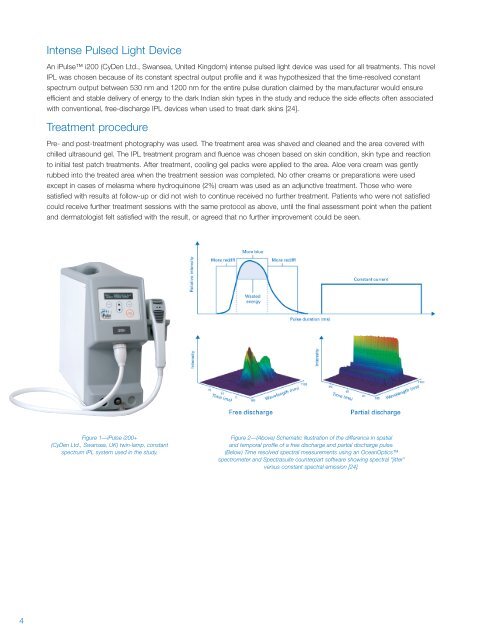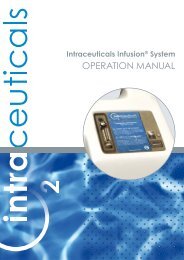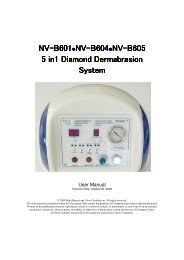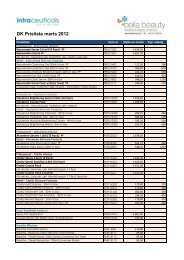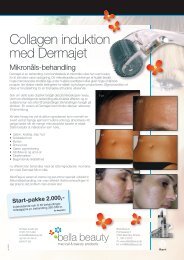Use of Intense Pulsed Light (IPL) in Indian Skin Types - ResearchGate
Use of Intense Pulsed Light (IPL) in Indian Skin Types - ResearchGate
Use of Intense Pulsed Light (IPL) in Indian Skin Types - ResearchGate
- No tags were found...
Create successful ePaper yourself
Turn your PDF publications into a flip-book with our unique Google optimized e-Paper software.
<strong>Intense</strong> <strong>Pulsed</strong> <strong>Light</strong> DeviceAn iPulse i200 (CyDen Ltd., Swansea, United K<strong>in</strong>gdom) <strong>in</strong>tense pulsed light device was used for all treatments. This novel<strong>IPL</strong> was chosen because <strong>of</strong> its constant spectral output pr<strong>of</strong>ile and it was hypothesized that the time-resolved constantspectrum output between 530 nm and 1200 nm for the entire pulse duration claimed by the manufacturer would ensureefficient and stable delivery <strong>of</strong> energy to the dark <strong>Indian</strong> sk<strong>in</strong> types <strong>in</strong> the study and reduce the side effects <strong>of</strong>ten associatedwith conventional, free-discharge <strong>IPL</strong> devices when used to treat dark sk<strong>in</strong>s [24].Treatment procedurePre- and post-treatment photography was used. The treatment area was shaved and cleaned and the area covered withchilled ultrasound gel. The <strong>IPL</strong> treatment program and fluence was chosen based on sk<strong>in</strong> condition, sk<strong>in</strong> type and reactionto <strong>in</strong>itial test patch treatments. After treatment, cool<strong>in</strong>g gel packs were applied to the area. Aloe vera cream was gentlyrubbed <strong>in</strong>to the treated area when the treatment session was completed. No other creams or preparations were usedexcept <strong>in</strong> cases <strong>of</strong> melasma where hydroqu<strong>in</strong>one (2%) cream was used as an adjunctive treatment. Those who weresatisfied with results at follow-up or did not wish to cont<strong>in</strong>ue received no further treatment. Patients who were not satisfiedcould receive further treatment sessions with the same protocol as above, until the f<strong>in</strong>al assessment po<strong>in</strong>t when the patientand dermatologist felt satisfied with the result, or agreed that no further improvement could be seen.Figure 1—iPulse i200+(CyDen Ltd., Swansea, UK) tw<strong>in</strong>-lamp, constantspectrum <strong>IPL</strong> system used <strong>in</strong> the study.Figure 2—(Above) Schematic illustration <strong>of</strong> the difference <strong>in</strong> spatialand temporal pr<strong>of</strong>ile <strong>of</strong> a free discharge and partial discharge pulse.(Below) Time resolved spectral measurements us<strong>in</strong>g an OceanOpticsspectrometer and Spectrasuite counterpart s<strong>of</strong>tware show<strong>in</strong>g spectral “jitter”versus constant spectral emission [24].4


